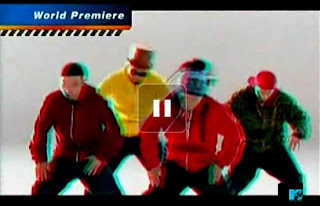Hit & Missy 3D in Stereoscopic HipHop Video

3D HipHop Music Video for Pure Slime's Watch How We Blow
A small, independent, low-budget music video production in 3-D: words that seem to be at odds with each other. East London-based Hip Hop act Pure Slime approached London directors Ashley Dagg-Heston and Bruno Sardinha of Ruffhouse Productions in January 2008 with a mission to produce an explosive music video for their latest release ‘Watch how we Blow’. Ruffhouse found DOP Robert McGowan, who quickly suggested doing the video in 3-D – the first one in music video history as far as they could see – as Ruffhouse had a clear vision of the artists propelling themselves into the living room from a ticking bomb. 3-D Stereoscopic Consultant Alexander Lentjes of 3-D Revolution Productions was approached to pull off spectacular 3-D on HDV, on a budget, with little more than inventiveness and professionalism on his side.
3D Still of The FrenchLine, another 1950's 3D musical
Being a 3-D film buff, Alexander was quick to note that this was not going to be the first 3-D music video in history. Although the very first British Hip Hop music video in 3-D, ‘Watch how we Blow’ has been preceded by 1953’s famous 3-D musicals ‘Kiss me Kate’ and 'The French Line', 1998’s infamous ‘Psycho Circus’ by Kiss, 2005’s 3-D Duran Duran video of ‘I don’t want your love’, and most recently in February 2008 Missy Elliott’s ‘Ching-A-Ling’.
Beaten in terms of release date, it was thus a case of beating these previous releases for 3-D quality and effectiveness. The over-hyped ‘Ching-A-Ling’ is certainly not 3-D Bling-A-Ling and can easily be called Hit-and-Missy 3-D. For the cinematographic use of 3-D and even the 3-D effect itself, the Hackney boys have got the LA Hip Hop superstar well beat. Where Missy spent 200,000 Pounds with ease, Ruffhouse had to work with something closer to 2,000 Pounds. But with 3-D, budget isn’t everything – understanding its potential is.
Missy Elliott watches her video Ching-a-Ling in 3-D
A 3-D HD shoot means twice the cameras, twice the compositing and a bit of work in getting the 3-D material aligned. There is always some deviation between two cameras, unless a very precisely aligned - and usually very expensive – camera rig is used. So that sort of 3-D post correction is unavoidable. Where big budget shoots opt for beamsplitting mirror rigs to control the interaxial value to human eye-distance and below, the rent of such 3-D rigs can quickly become prohibitive in terms of budget spend. With 2,000 Pounds it’s either a whole 2 day shoot and 3 day post or 1 day with a 3-D mirror rig and no studio.
Greenscreen 3D HD Shoot
Both the ‘Ching-A-Ling’ and ‘Watch how we Blow’ videos are intended to be seen mainly online and occasionally on TV. This means the main delivery format is relatively small in size and will have quite a bit of compression to it. But the high budget LA production of Missy Elliott uses 3-D interaxial camera values that are suitable for a movie theatre, which results in a very shallow and hardly 3-D volumetric end result in the actual release format. On top of this ‘think big’ mistake, the very fact that performers in the video are wearing red and blue clothes means that the 3-D presentation format of the video was completely overlooked. They may have had polarized projection and big frame sequential LCD screens in the Walt Disney studios where this was shot, but the main release format is anaglyph 3-D, which relies on red and blue colour values to filter the 3-D to the correct eyes. So seeing ‘Ching-A-Ling’ in its actual release format is a big disappointment and even an unpleasant experience. The production of ‘Watch how we Blow’ was determined not to make the same mistakes and deliver impressive 3-D in the way it is supposed to be experienced.
The way most people will see Ching-A-Ling in 3-D: online, small, compressed
Alexander Lentjes: “The brief I got was that the 3-D imagery had to be larger than life, in your face, and mainly exploding off the screen into your living room. That means extreme use of 3-D, with interaxial values that most stereographers would never dare touch being that close to the subject matter with the 3-D cameras. The budgetary constraint of having to shoot without mirror rig thus became a great strength as the side-by-side Panasonic HVX 200’s produced the exact interaxial I knew would create an extremely volumetric 3-D image. And I am very pleased with the actual end result”
As part of the 2-day shooting schedule was a green screen shoot, there was the ability to count on recentration in post, making the 3-D fuseable by eye and brain. After this frame distance change, the stereoscopic depth can be pushed even further with a composited 3-D background. Part of the video features 3-D background material shot with twin-Sony A1’s, shot at 1080i - as with the Panasonic material. Although the video will be presented in SD on TV and mainly through the web in sub-SD sizes, the HD format of the source material means much more manoeuvrability when it comes to 3-D recentration, scaling and cropping. These are production parts intrinsic to 3-D stereoscopic video and it can be very frustrating when there is not enough resolution to work with in post.
Still from Watch how we Blow in Stereoscopic 3-D
The music video starts as CCTV footage of a lab where a ticking bomb is about to produce the explosive act of Pure Slime. Because this footage is in Black&White, the 3-D footage will actually tie in well in the Black&White anaglyph format, where no attempt is made to reproduce colours naturally, but only red and cyan are used as colours. As they are opposite colours on the colour wheel, this means the end result in indeed Black&White. Any possible mistakes of red and blue clothes in an anaglyph video are certainly very much avoided in this way and when one chooses to present a video in anaglyph 3-D, which means ending up with difficult to distinguish colours through the red&blue glasses, why try very hard to have colours anyway? Leave that to the 2-D version!
Speaking of colour, a typical situation arose on the day of the Green Screen shoot, when the artists turned up with green shirts and hankies – the Pure Slime posse colours. Some quick switching over of shirts and sweaters solved that problem, but the boys were obviously not very happy about this. As green screen shooting imposes colour limitations on the subject matter, 3-D shooting for (colour) anaglyph has its added on do’s and don’ts. An unavoidable part of any 3-D technique is that it imposes limitations and every 3-D technique has different quirks. Anaglyph is particular on the colours, but in the same way polarized 3-D projection doesn’t work well with high contrast and very low lighting. When you know these limitations and respect them, you can produce professional quality 3-D, while using the stylistic peculiarities to your cinematographic advantage.
Some of the composited background material features rare declassified US military 3-D stereoscopic stock footage of Nuclear Blasts and destruction from the 1940’s and 50’s. A rarely known fact is that not just 3-D, but Technicolor was perfected for film use by the US military to be able to shoot Nuclear Blasts as detailed as possible. So the 3-D process comes full circle with a Hackney 3-D Hip Hop video shoot backed by original 3-D footage from the birth years of serious 3-D film development. What would those generals have said had they known this would happen? A very loud: “Blast!”
“Watch how we Blow”
By
Pure Slime
www.myspace.com/94057249
Featuring
Rawz Artillery
Dread Marachi
Produced by
Ruffhouse Productions
www.rhousefilm.com
Directed by
Ashley Dagg-Heston
Bruno Sardinha
DOP & Camera OP
Robert McGowan
www.mediaedit.co.uk
Stereoscopic 3-D Consultant
Alexander Lentjes
www.the3drevolution.com
Shot on
2x Panasonic HVX 200 P2 (HDV)
2x Sony A1 (HDV)




